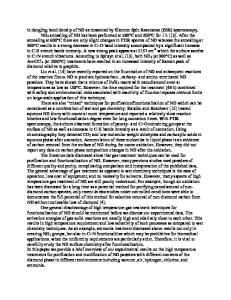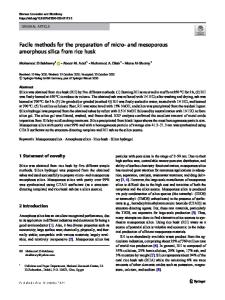Low Temperature Fabrication and Surface Modification Methods for Fused Silica Micro- and Nanochannels
- PDF / 329,387 Bytes
- 12 Pages / 432 x 648 pts Page_size
- 41 Downloads / 318 Views
Low Temperature Fabrication and Surface Modification Methods for Fused Silica Micro- and Nanochannels Sumita Pennathur and Pete Crisalli Mechanical Engineering Department, University of California, Santa Barbara Santa Barbara, CA 93106 U.S.A.
ABSTRACT Electrokinetic based micro- and nanofluidic technologies provide revolutionary opportunities to separate, identify and analyze biomolecular species. Key to fully harnessing the power of such systems is the development of a robust method for integrated electrodes as well as a thorough understanding of the influence of the electrokinetic surface properties with and without different surface modifications. In this work, we demonstrate a surface micromachined fabrication approach for integrated addressable metal electrodes within centimeter-long nanofluidic channels using a low-temperature, xenon diflouride dry-release method for novel biosensing applications, as well as recent results from a joint theoretical and experimental study of electrokinetic surface properties in nano- and microfluidic channels fabricated with fused silica. The main contribution of this fabrication process involves the addition of addressable electrodes to a novel dry-release channel fabrication method, produced at 1000c) [22, 23]. Sacrificial etching offers superior topological flexibility as it creates nanochannels by removing a patterned material enclosed by other deposited layers. The existing methods in sacrificial layer removal can be categorized by the phase of the etchant used: either wet (liquid etchants) or dry (plasma or vapor etchants) processes. Wet processes offer good selectivity but subject the released channels to possible structural failure due to stiction [21, 24]. Plasma processes solve such stiction problems but are ineffective for etching long and thin gaps due to the limited extension of the electromagnetic field into small gaps [25, 26]. However, vapor processes also offer low mechanical impact on released structures while remaining capable of etching without line of sight. In particular, XeF2 has demonstrated etch rates >2mm/min and a selectivity of >1000 between Si and SiO2 [27]. But releasing centimeter-long nanochannels continues to pose challenges due to the diffusionlimited long etching time described by the Deal-Grove model [28]. However, the use of fused silica as a surface in micro- and nanochannels presents an inherent barrier to further utilization of novel techniques. Strong adhesion of many biological components, particularly proteins and small molecules, creates many problems in the application and utility of new devices. Surface modification using a self-assembled monolayer offers a simple approach for modifying glass surfaces in existing device designs for biological analysis and applications. While modification of PDMS has been widely explored for advancement of microfluidic devices, controlled modification of fused silica nanochannels remains challenging. Consequently, fused silica devices are still prone to poor separation of complex biomolecules and req
Data Loading...










